Though the birth of the automobile
didn’t coincide with the birth of the road trip, the development of
automobile technology and the post-World-War-II boom of the late
1940s, encouraged Americans to get out and see the countryside. But
road trips are nothing if they don’t have some sort of destination,
and amusement parks provided all the fun a destination could have in
one place.
Unlike the overly expensive theme parks frequented by many of
today’s upwardly mobile families, amusement parks were designed for
the masses as places where everyone from every class could have
fun—cheaply.
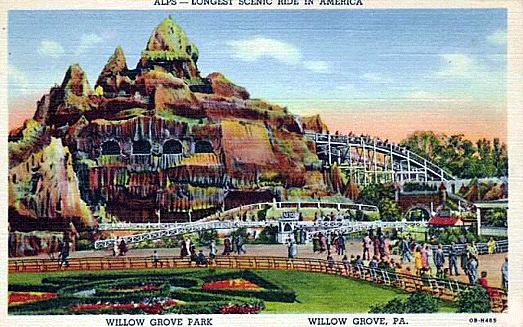
Some parks, like Willow Grove Park outside Philadelphia,
Pennsylvania, which opened in 1896, have all but passed into memory.
Today, a shopping mall has replaced it. Others like Idlewild and
Kennywood, both outside of Pittsburgh, are still in operation, and
some say better than ever.
Idlewild Park
As the fourth oldest amusement park still in operation in the United
States, Idlewild has been providing family fun for over a century.
The park opened in May, 1878 when William Darlington gave Judge
Thomas Mellon, the owner of the Ligonier Valley Railroad, the right
to occupy his land for a picnic grove. Mellon wanted to develop a
park that included campgrounds, an artificial lake for fishing and
boating, a picnic grove, and a large hall for entertainment.
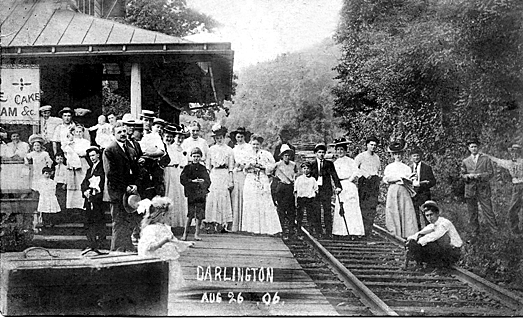
Mellon promoted the new park to church and school groups as a place
to have fun in a wholesome country atmosphere. In addition, city
dwellers found Idlewild the perfect place to get away for a weekend
in the country where they could enjoy a variety of family activities
including boating, fishing, picnicing and the main attraction, a
carousel.
For 53 years Idlewild remained as a
purely recreational park, then in 1931 Richard Mellon, (the son of
Judge Mellon) and C. MacDonald joined forces and pooled their
resources to bring amusements to the park. As manager, MacDonald
planned and supervised the construction of rides, pavilions,
lunchrooms, bandstands and many attractions which are still part of
Olde Idlewild today. Situated here is the park's beautiful three-row
Philadelphia Toboggan Company carousel, the third one that has been
in operation since the late 1880s.
In 1951, with the park located just off the old Lincoln Highway
(U.S. Route 30) and easily accessible by automobile, the Ligonier
Valley Railroad was discontinued. This, however, did not affect the
popularity and growth of Idlewild and it continued to expand under
MacDonald's ownership.
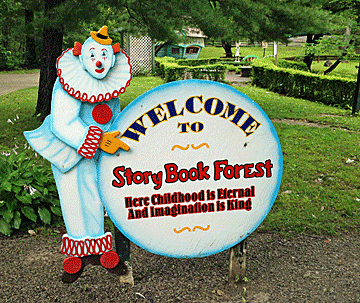 In
1956 Story Book Forest was added, a quaint woodland village based on
popular nursery rhymes and fairy tales. A stroll through the
"forest" is a delight to children as they are free to roam about and
are encouraged to visit the many charming cottages of their favorite
story book characters. Here they can meet the folks who "live"
there, all dressed in wonderful costumes and enthusiastically
sharing their tales of adventure in the land of make believe.
In
1956 Story Book Forest was added, a quaint woodland village based on
popular nursery rhymes and fairy tales. A stroll through the
"forest" is a delight to children as they are free to roam about and
are encouraged to visit the many charming cottages of their favorite
story book characters. Here they can meet the folks who "live"
there, all dressed in wonderful costumes and enthusiastically
sharing their tales of adventure in the land of make believe.
In 1983 Kennywood Park Corp. took over Idlewild and began to expand
the attractions of the park to include Jumpin' Jungle, a chills
activity area; Hootin' Holler which was at one time called Historic
Village; H2Ohhh Zone, which includes the pool and six wild water
rides; Racoon Lagoon, offering 8 acres of kiddie rides; and Mr.
Roger's Neighborhood, complete with trolley car.
From Trolley Park to Amusement Park
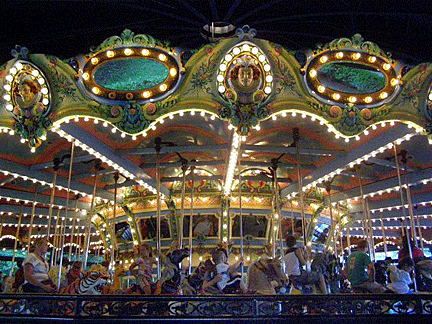 Kennywood
Park began, much as Willow Groove Park did for the Philadelphia
area, as a trolley park by the Monogahela Street Railway for the
Pittsburgh area in 1898. And while only two buildings remain from
the original park—a carousel pavilion and a restaurant—the Kennywood
Park Corporation has opened a new section called Lost Kennywood,
modeled after amusement parks at the turn of the century called Luna
Parks.
Kennywood
Park began, much as Willow Groove Park did for the Philadelphia
area, as a trolley park by the Monogahela Street Railway for the
Pittsburgh area in 1898. And while only two buildings remain from
the original park—a carousel pavilion and a restaurant—the Kennywood
Park Corporation has opened a new section called Lost Kennywood,
modeled after amusement parks at the turn of the century called Luna
Parks.
Luna Parks were introduced by F.W. Thompson, and the first one was
located in Coney Island, N.Y. The parks and the light bulb came into
being at the same time and the parks were built to showcase Edison's
invention with buildings and the midway out-lined in lights.
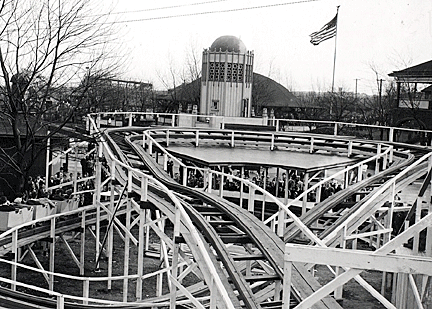 While
Luna Parks were established by Thompson, Frederick Ingersoll built
many of them around the world including one in the Oakland section
of Pittsburgh in 1905. Ingersoll's Luna Park was one of 13 amusement
parks which were located in Allegheny County, Pa., during the first
decade of this century. Because Kennywood is the only survivor of
those 13 parks, it seems only fitting that Lost Kennywood's design
should honor the Luna Park and Ingersoll. Ingersoll actually did
have a connection to Kennywood. He designed and built the park's
first roller coaster, the Figure Eight in 19O2.
While
Luna Parks were established by Thompson, Frederick Ingersoll built
many of them around the world including one in the Oakland section
of Pittsburgh in 1905. Ingersoll's Luna Park was one of 13 amusement
parks which were located in Allegheny County, Pa., during the first
decade of this century. Because Kennywood is the only survivor of
those 13 parks, it seems only fitting that Lost Kennywood's design
should honor the Luna Park and Ingersoll. Ingersoll actually did
have a connection to Kennywood. He designed and built the park's
first roller coaster, the Figure Eight in 19O2.
Luna Parks were known for their midways which were an imitation of
the great expositions of the 1890s. The midways included a variety
of attractions such as rides, food and entertainment. Luna Parks
were also known for their centerpiece ride "Shoot-the-Chute" a water
ride known for creating such a huge wave that even the spectators
got soaked.
The Original Luna Parks
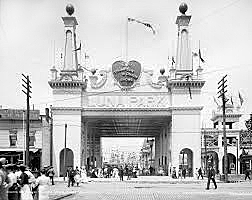 Luna
Park was an amusement park in Coney Island, Brooklyn, New York that
opened in 1903. Built partly on the grounds of Sea Lion Park (1895),
it was one of the three original iconic large parks built on Coney
Island, the other two being Steeplechase Park (1897) and Dreamland
(1904).
Luna
Park was an amusement park in Coney Island, Brooklyn, New York that
opened in 1903. Built partly on the grounds of Sea Lion Park (1895),
it was one of the three original iconic large parks built on Coney
Island, the other two being Steeplechase Park (1897) and Dreamland
(1904).
The original Luna Park on Coney
Island, a massive spectacle of rides, ornate towers and cupolas
covered in 250,000 electric lights, was opened in 1903 by the
showmen and entrepreneurs Frederic Thompson and Elmer "Skip" Dundy.
The park was either named after the fanciful airship Luna, part of
the new park's central attraction A Trip to the Moon, or after
Dundy's sister. Luna Park was a vastly expanded attraction built
partly on the grounds of Sea Lion Park,
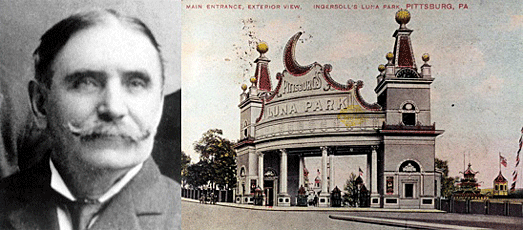
In 1905, Frederick Ingersoll, who was
already making a reputation for his pioneering work in roller
coaster construction and design (he also designed scenic railroad
rides) borrowed the name when he opened Luna Park in Pittsburgh and
Luna Park in Cleveland. These first two amusement parks, like their
namesake, were covered with electric lighting (the former was
adorned with 67,000 light bulbs; the latter, 50,000). Later, in
1907, Charles Looff opened another Luna Park in Seattle, Washington.
Ultimately, Ingersoll opened 44 Luna Parks around the world, the
first chain of amusement parks.
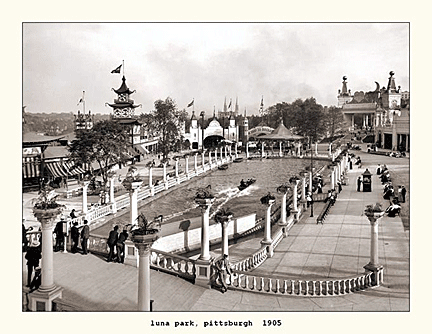 Luna
Park was an amusement park in Pittsburgh, Pennsylvania, USA, from
1905 to 1909. Constructed and owned by Frederick Ingersoll, the park
occupied a 16-acre hilly site bounded by Baum Boulevard, North Craig
Street, and Centre Avenue, and included roller coasters, picnic
pavilions, carousels, a fun house, a Ferris wheel, a roller rink, a
shoot-the-chutes ride, a concert shell, a dance hall, bumper cars,
and a baby incubator exhibit. In its brief existence, the park
featured regular performances of bands, acrobatic acts, animal acts,
horse riders, and aerial acts.
Luna
Park was an amusement park in Pittsburgh, Pennsylvania, USA, from
1905 to 1909. Constructed and owned by Frederick Ingersoll, the park
occupied a 16-acre hilly site bounded by Baum Boulevard, North Craig
Street, and Centre Avenue, and included roller coasters, picnic
pavilions, carousels, a fun house, a Ferris wheel, a roller rink, a
shoot-the-chutes ride, a concert shell, a dance hall, bumper cars,
and a baby incubator exhibit. In its brief existence, the park
featured regular performances of bands, acrobatic acts, animal acts,
horse riders, and aerial acts.
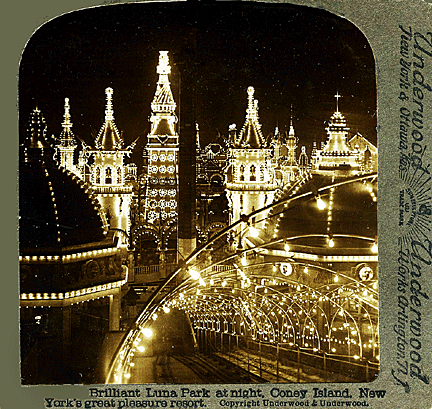 The
first amusement park to be covered with 67,000 electric light bulbs.
The park cost $375,000 to construct; re-creating it from scratch
today would cost approximately $8,500,000.
The
first amusement park to be covered with 67,000 electric light bulbs.
The park cost $375,000 to construct; re-creating it from scratch
today would cost approximately $8,500,000.
The Pittsburgh Luna Parks were the beginnings of the world's first
amusement park chain: by 1929, the year Ingersoll died), there were
44 Luna Parks around the world.
The cost of upgrading and maintaining his amusement parks proved too
much for Ingersoll as he was forced to declare bankruptcy in 1908.
Several of the Luna Parks were sold to others; Pittsburgh's park was
closed in 1909 in the face of competition of a second trolley park
nearby, the older (and still-existing) Kennywood Park. When
Kennywood expanded its fairgrounds in 1995, its new Lost Kennywood
section was patterned after its former competitor, centered on a
shoot-the-chutes ride and having a one-third-scale replica of the
Luna Park entrance as a "gateway" to the park.
The Luna Park on Coney Island in Brooklyn, New York, opened in 1903.
One of the three iconic parks built on Coney Island, it was mostly
destroyed by a fire in 1944.

In 1901 the park's creators, Frederic Thompson and Elmer "Skip"
Dundy, had created a wildly successful ride called "A Trip To The
Moon", as part of the Pan-American Exposition at Buffalo, New York.
The name of the fanciful "airship" (complete with flapping wings)
that was the main part of the ride was Luna, the Latin word for the
moon. The airship, and the later park built around it may have been
named after Dundy's sister in Des Moines, Luna Dundy Newman.
At the invitation of Steeplechase owner Harry George Tilyou,
Thompson and Dundy moved their show to Steeplechase Park, a Coney
Island amusement park, for the 1902 season. The deal ended at the
end of the summer after Thompson and Dundy rejected a Tilyou's
contract renewal offer that cut their take of the profits by 20%.
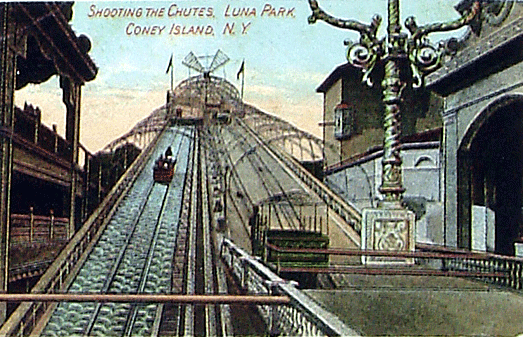
At the end of 1902 season Thompson
and Dundy signed a long-term lease for Paul Boyton's Sea Lion Park.
Sea Lion, the first large scale enclosed park at Coney island, had
opened 7 years before. The park had several centerpiece rides but a
bad summer season and competition with Steeplechase Park made Boyton
decide to get out of the amusement park business. Besides the
16-acre Sea Lion Park Thompson and Dundy also leased the adjacent
land where the Elephantine Colossus Hotel had stood until it burned
down in 1896. This gave them 22 acres, all the land north of Surf
Avenue and south of Neptune Avenue and between W. 8th and W. 12th
Street, to build a much larger park.
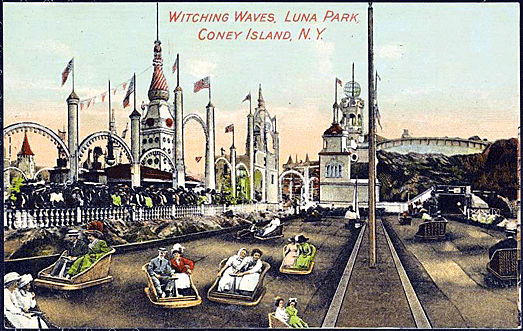
Thompson and Dundy spent $700,000, although they advertised it as
$1,000,000, totally rebuilding the park and expanding its
attractions. The park's architectural style was an Oriental theme
with buildings built on a grand scale and over 1,000 red and white
painted spires, minarets and domes. At night all the domes, spires
and towers were lit with over 250,000 electric lights. At the center
of the park in the middle of a lake was the 200 foot tall Electric
Tower that was decorated with twenty thousand incandescent lamps, a
smaller version of the Electric Tower that was the crowning feature
of the Pan-American Exposition two years earlier. At the base of the
tower was a series of cascading fountains. Eventually two circus
rings were suspended over the central lagoon to keep customers
entertained between rides.
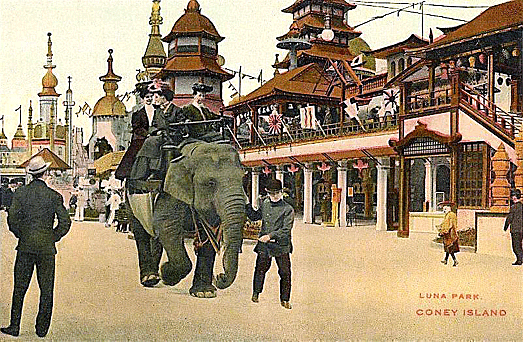
Calling itself as "The heart of Coney Island", Luna Park turned on
its lights and opened its gates to a crowd of 60,000 spectators
precisely at 8:05pm on May 16, 1903, coinciding with the timing of
sunset on that Saturday night.[6] Admission to the park was ten
cents with rides costing extra, up to 25 cents for the most
elaborate rides.
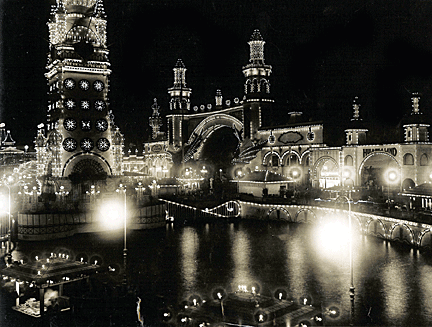 But
the lights of Luna Park grew dim as a succession of owners tried to
keep it going. When the Great Depression hit, the park went into
bankruptcy several times, starting in 1933. Many of the exhibits,
rides and shows from the 1939 New York World's Fair moved to Luna
Park after the Fair closed and Luna was billed as the New York
World's Fair of 1941. With the US entry into World War II Luna was
allowed to stay open as a morale booster but had to keep its lights
dimmed for wartime security.
But
the lights of Luna Park grew dim as a succession of owners tried to
keep it going. When the Great Depression hit, the park went into
bankruptcy several times, starting in 1933. Many of the exhibits,
rides and shows from the 1939 New York World's Fair moved to Luna
Park after the Fair closed and Luna was billed as the New York
World's Fair of 1941. With the US entry into World War II Luna was
allowed to stay open as a morale booster but had to keep its lights
dimmed for wartime security.
But a pair of devastating fires in 1944 and again in 1946 marked the
death knell of the park, and like Willow Grove Park, its owners sold
the land to a developer who built an apartment complex.
